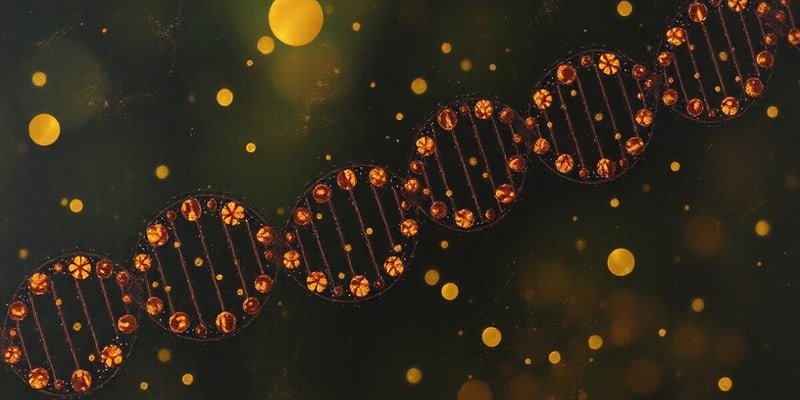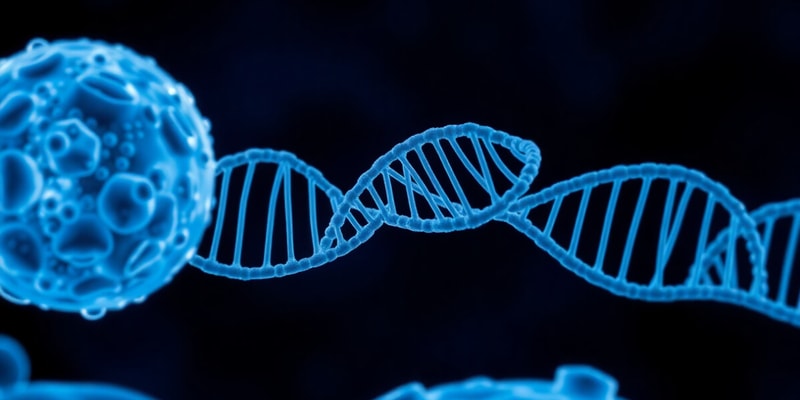Podcast
Questions and Answers
What characterizes the initiation of DNA replication in eukaryotes?
What characterizes the initiation of DNA replication in eukaryotes?
Which of the following statements about the steps of DNA replication is true?
Which of the following statements about the steps of DNA replication is true?
What is the role of licensing factors during DNA replication in eukaryotes?
What is the role of licensing factors during DNA replication in eukaryotes?
How are Autonomously Replicating Sequences (ARS) significant in eukaryotic DNA replication?
How are Autonomously Replicating Sequences (ARS) significant in eukaryotic DNA replication?
Signup and view all the answers
What is the primary function of the helicases during the initiation of DNA replication?
What is the primary function of the helicases during the initiation of DNA replication?
Signup and view all the answers
What is the primary role of helicases in DNA replication?
What is the primary role of helicases in DNA replication?
Signup and view all the answers
During which phase of the cell cycle is helicase loading primarily performed?
During which phase of the cell cycle is helicase loading primarily performed?
Signup and view all the answers
Which of the following DNA polymerases is specifically responsible for mitochondrial DNA replication?
Which of the following DNA polymerases is specifically responsible for mitochondrial DNA replication?
Signup and view all the answers
What is a key function of the proliferating cell nuclear antigen (PCNA)?
What is a key function of the proliferating cell nuclear antigen (PCNA)?
Signup and view all the answers
Which polymerase does not possess proofreading capability?
Which polymerase does not possess proofreading capability?
Signup and view all the answers
What happens to RNA primers during the DNA elongation process?
What happens to RNA primers during the DNA elongation process?
Signup and view all the answers
In the context of the replisome progression complex, which component is essential for lagging strand replication?
In the context of the replisome progression complex, which component is essential for lagging strand replication?
Signup and view all the answers
How are primed DNA strands prepared for subsequent polymerase binding?
How are primed DNA strands prepared for subsequent polymerase binding?
Signup and view all the answers
What is the primary issue caused by the end replication problem in DNA replication?
What is the primary issue caused by the end replication problem in DNA replication?
Signup and view all the answers
How do telomeres contribute to solving the end replication problem?
How do telomeres contribute to solving the end replication problem?
Signup and view all the answers
What happens to cells when telomeric DNA is significantly reduced?
What happens to cells when telomeric DNA is significantly reduced?
Signup and view all the answers
What is a possible consequence of further end loss in DNA strands?
What is a possible consequence of further end loss in DNA strands?
Signup and view all the answers
Which of the following cell types is known to divide more than the Hayflick limit?
Which of the following cell types is known to divide more than the Hayflick limit?
Signup and view all the answers
What specific sequence is commonly found repeated in human telomeres?
What specific sequence is commonly found repeated in human telomeres?
Signup and view all the answers
What occurs when the last 20-200 nucleotides of telomeric DNA are single-stranded?
What occurs when the last 20-200 nucleotides of telomeric DNA are single-stranded?
Signup and view all the answers
What is the term for the phenomenon where cells stop dividing after a certain number of replications due to telomere shortening?
What is the term for the phenomenon where cells stop dividing after a certain number of replications due to telomere shortening?
Signup and view all the answers
What is the physiological role of telomerase?
What is the physiological role of telomerase?
Signup and view all the answers
Which enzyme is responsible for synthesizing the leading strand in mitochondrial DNA replication?
Which enzyme is responsible for synthesizing the leading strand in mitochondrial DNA replication?
Signup and view all the answers
What unique property does the RNA-dependent RNA polymerase possess in viral RNA genomes?
What unique property does the RNA-dependent RNA polymerase possess in viral RNA genomes?
Signup and view all the answers
What happens to the RNA half of the retroviral genome after reverse transcription?
What happens to the RNA half of the retroviral genome after reverse transcription?
Signup and view all the answers
In bacteriophage replication, what role does the 'nick' play?
In bacteriophage replication, what role does the 'nick' play?
Signup and view all the answers
What is a common feature of the replication mechanism used by retroviruses such as HIV?
What is a common feature of the replication mechanism used by retroviruses such as HIV?
Signup and view all the answers
Which of the following statements regarding DNA replication is NOT accurate?
Which of the following statements regarding DNA replication is NOT accurate?
Signup and view all the answers
What type of replication occurs with mitochondrial DNA?
What type of replication occurs with mitochondrial DNA?
Signup and view all the answers
Study Notes
DNA Replication Overview
- DNA replication is a complex process, but the fundamental principles, enzymes, and steps are surprisingly similar across all life forms.
- DNA synthesis is comparatively simple.
DNA Replication Lecture 7
- The lecture outlines the composition/structure of DNA.
- It contrasts DNA synthesis with DNA replication.
- Key details of replication problems and solutions in E. coli are explored.
- The replication process in E. coli is broken down into three steps.
- Differences in replication between eukaryotes and viruses are discussed.
DNA Replication Steps: Initiation, Elongation, Termination
- The process of DNA replication is divided into three stages: Initiation, Elongation, and Termination.
- The stages are described in questions about "How does replication start?", "How does replication progress?", and "How does replication stop?".
Eukaryotic DNA Replication: Initiation
- Initiation is tightly linked to the cell cycle.
- Initiation must only occur once per cell cycle.
- A two-step process ensures this.
- Origins of replication (ARS) are sections of DNA.
- ARS are separated (on different chromosomes), typically by approximately 30 kb.
- The number of origins varies, from 10 in small chromosomes to thousands in large ones.
- A key AT-rich consensus sequence is found in yeast (a specific region) 5' - T/ATTTAYRTTTT/A -3'
Eukaryotic DNA Replication: Initiation/Licensing (G1 phase)
- An Origin Recognition Complex (ORC) of proteins binds to the DNA's A region.
- Accessory proteins called licensing factors accumulate in the nucleus during G1.
- Cdc6 and Cdt1 bind to ORC.
- Two helicases are loaded by Cdt1 onto double-stranded (ds) DNA.
- Cdc6/Cdt1 proteins detach.
- This process forms a "licensed" pre-replication complex.
Eukaryotic DNA Replication: Initiation/Activation (S phase)
- The pre-replication complex must be activated during the S phase.
- Additional proteins are recruited to form an active initiation complex/replisome progression complex.
Eukaryotic DNA Replication: Initiation Overview
- G1 phase: Helicase loading occurs, but no helicase activation.
- S phase: No helicase loading, but helicases are activated.
- Replisome progression complex comprises many proteins, including polymerases.
Eukaryotic DNA Replication: Elongation (Polymerases)
- Five main eukaryotic DNA polymerases exist: α, β, γ, δ, and ε.
- Polymerase α has both primase and polymerase activity, meaning it generates its own primers.
- It lacks a 3'-5' exonuclease for proofreading.
- Polymerase α is not very processive.
- Replication factor C (RFC) loads proliferating cell nuclear antigen (PCNA) onto the primer/DNA to allow another polymerase to bind.
Eukaryotic DNA Replication: Elongation (Polymerases continued)
- Polymerase β is involved in DNA repair.
- Polymerase γ replicates mitochondrial DNA (mtDNA) and has proofreading capabilities.
- Polymerase δ (for lagging strand) associates with PCNA and possesses proofreading.
- Polymerase ε (for leading strand) associates with PCNA and has proofreading.
Eukaryotic DNA Replication: Elongation - Editing
- Polymerase δ can displace RNA primers, but can't directly release them as rNMPs.
- Flap endonuclease-1 (FEN1) identifies and cuts off 5' flaps, leaving a nick.
- DNA ligase fills the nick to complete the DNA strand.
- RNase H2 can digest primers, primarily. FEN1 then removes any remaining RNA nucleotides.
Eukaryotic DNA Replication: Elongation: Overview
- Not every pre-replication complex is used in each round of replication.
- Replication forks initially from one origin can traverse and pass through another origin.
- Passive replication results from this process.
- Humans have roughly 5 x 10⁴ (50,000) origins for replication, for their large genome.
Eukaryotic DNA Replication: Linear Chromosomes and the End Replication Problem
- The end replication problem is a result of the lagging strand in linear chromosomes.
- The last RNA primer may not be located at the DNA's 3' end, leading to an unreplicated segment.
- Even if the RNA primer is at the end, it gets removed, leaving a segment of ssDNA.
Eukaryotic DNA Replication: Linear Chromosomes and Telomeres
- Telomeres are the solutions to the end replication problem in eukaryotic linear chromosomes.
- Telomeres contain repeated sequences (e.g., TTAGGG).
- These repeated sequences are not genes.
- Telomeres protect the chromosome ends through repetitive, simple sequences.
- The final 20-200 nucleotides at the 3' end are ssDNA.
Eukaryotic DNA Replication: Telomeres and the Hayflick Limit
- Cells stop dividing if telomeric DNA is gone, achieving the Hayflick limit.
- This loss of telomeric repeats leads to a loss of genetic material.
- Short telomeres are often associated with senescence, where cells stop dividing.
Eukaryotic DNA Replication: Telomerase and Embryonic Cells
- Telomerase is a ribonucleoprotein enzyme that synthesizes telomeric repeats.
- Embryonic, cancer, and stem cells utilize telomerase to synthesize new telomeric DNA.
- Telomerase employs an RNA template (about 450 nucleotides long) for adding telomeric repeats. This process extends the telomere.
Eukaryotic DNA Replication: Telomerase (Solution) Summary
- Telomerase binds and extends the ssDNA of the telomere.
- Pol α (primase) binds and produces a primer in the process.
- Pol δ then binds the primer and extends the newly made region.
- DNA ligase closes up the nick in the new DNA sequence.
Eukaryotic DNA Replication: Mitochondrial DNA (mtDNA)
- mtDNA exists in 2-10 copies of circular mtDNA per mitochondrion,.
- Replication of mtDNA is unidirectional, employing only one fork.
- Leading strand synthesis is by Pol γ.
- Okazaki fragments (made of RNA) are used to synthesize the lagging strand.
Viral DNA Replication: Bacteriophages
- Some phages (bacteriophages) replicate using the "rolling circle" method.
- This method allows the continuous synthesis of new DNA.
- Sigma (σ) replications are common mechanisms in these viruses.
Viral DNA Replication: RNA Genomes
- Some animal/plant viruses have RNA genomes.
- RNA-dependent RNA polymerases (RNA replicases) are used for replication.
- Plus strands of RNA are copied into minus strands, which then serve as templates for further plus strand creation.
- Some RNA viral genomes are self-priming, unlike DNA genomes.
- RNA viral genomes often lack proofreading, leading to high error rates in replication.
Viral DNA Replication: Retroviruses, e.g., HIV
- Retroviruses (like HIV) have RNA genomes.
- Reverse transcriptase is for creating DNA from RNA, using RNA genomes as templates.
- RNA can act as a template with tRNALys as a primer.
- The RNA half is degraded by RNase H.
- Second DNA strand is synthesized.
- The double-stranded DNA is incorporated into the host's genome.
DNA Replication Conclusions
- DNA synthesis (by itself) is comparatively simple.
- DNA replication is significantly complex.
- DNA replication principles, enzymes, and steps are universally similar across all life forms.
Studying That Suits You
Use AI to generate personalized quizzes and flashcards to suit your learning preferences.
Related Documents
Description
Test your knowledge on the initiation and processes of DNA replication in eukaryotes. This quiz covers key factors such as helicases, polymerases, and the significance of autonomously replicating sequences (ARS). Assess your understanding of the cell cycle phases related to DNA replication and the roles of various proteins involved.




